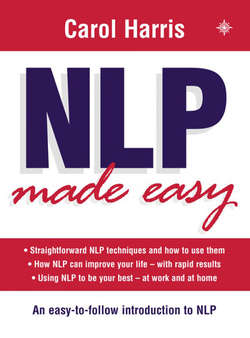Читать книгу NLP Made Easy - Carol Harris - Страница 8
Definitions
ОглавлениеBecause of its nature, different people perceive different things in NLP and gain different things from it; definitions of NLP, therefore, are numerous and varied. As well as the one given above, they have included the following:
‘an attitude which is an insatiable curiosity about human beings with a methodology that leaves behind it a trail of techniques’ (Richard Bandler)
‘an owner’s guide to the mind’
‘the study of subjective experience’
‘the study of the structure of subjectivity’ (Dilts, Bandler, Grinder, DeLozier, Neuro-Linguistic Programming: Volume 1)
‘software for the brain’
‘a new Science of Achievement’
‘the study of human excellence’
‘the ability to be your best more often’
‘the science that teaches how to use the neurological and linguistic resources in order to follow the program of self preservation, health and happiness in union with other people and nature’ (Luis Jorge Gonzales)
‘a manual for the structured use of creativity’ (Roz Carroll)
‘how to think positively so you can enhance your performance’
‘an adventure in experience’
As most of these definitions focus on personal improvement, one way of thinking of NLP is to consider it as providing a way of helping people move from situations which could be improved to situations which are better. Whereas other disciplines, such as psychology, give insights into human behaviour and motivation, NLP actually provides practical ways of improving performance. So it incorporates a technology for bringing about change in people, a set of approaches and tools which combine to offer ideas and skills for enhancing how people do things.
This can be summed up by saying that NLP helps people identify their present states (how they think and feel, what they do and the results they achieve), consider their desired states (what they would really like instead) and learn how to move from one to the other. It is not prescriptive about what the desired states should be, leaving that to the individual. For example, two people might both wish to become better at responding to other people’s criticism. The first person might become upset when criticized (their ‘present state’) and wish to ‘be able to accept criticism in a positive way’, while the second person might become defensive when criticized and wish to ‘be able to be receptive and use the criticism to bring about personal change’. Both people could be helped to achieve their aims using NLP techniques, but NLP does not tell them that one aim is ‘correct’ or ‘more desirable’ than another (although it can help them consider the advantages and disadvantages of each).
To achieve the transition from present state to desired state, there are three elements which NLP considers: you (your own situation and disposition); others (those with whom you are dealing) and flexibility (the possibility of varying what you do in order to be effective).
